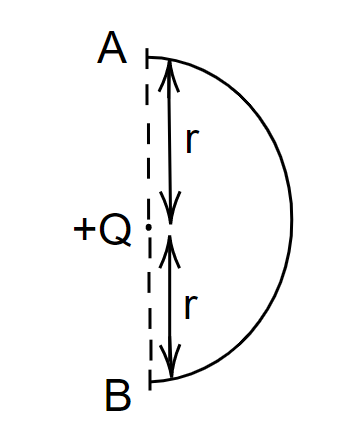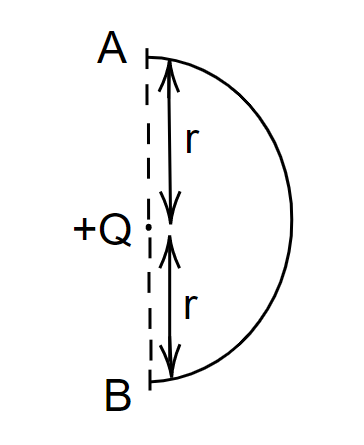
The work done in slowly moving an electron of charge e and mass m from A to B along a semi-circular path (as shown in the figure) in a vertical plane in the field of charge Q is

A. \[ - 2mgr\]
B. \[ - \dfrac{{Qe}}{r}\]
C. \[2mgr + \dfrac{{Qe}}{r}\]
D. Zero
Answer
224.7k+ views
Hint:Before we proceed with the problem, it is important to know about the work done by a charge and electric potential energy. It is defined as the force applied on a charge leading to a certain displacement in it. Electric potential energy can be defined as the total potential energy a unit charge will possess if located at any point in outer space.
Formula Used:
By the formula of electric potential energy we have,
\[V = \dfrac{{KQ}}{R}\]
Where, Q is the point charge and R is the distance between any point around the charge to the point charge.
Complete step by step solution:
Now we can able to solve the problem step by step as follows.

Image: An electron of charge e and mass m moving along a circular path.
We can say that the electric force acts on an electron when it is taken from point A to point B. Then the work has to be done by the electrostatic field and also the work has to be done against the gravitational field. So, work done in the electrostatic field is given by,
\[{W_{AB}} = q\left( {{V_B} - {V_A}} \right)\]
\[{W_{AB}} = e\left( {\dfrac{{KQ}}{R} - \dfrac{{KQ}}{R}} \right)\]
\[ \Rightarrow {W_{AB}} = 0\]
Then the work done against the gravitational field is
\[{W_{AB}} = mg\left( { - 2R} \right)\]
\[{W_{AB}} = - 2mgR\]
Hence, the net work done is,
\[{W_{AB}} = 0 + \left( { - 2mgR} \right)\]
\[ \therefore {W_{AB}} = - 2mgR\]
Therefore, the work done by the electric force will be equal \[ - 2mgr\] from point A to point B along this semi-circular path in the field of charge.
Hence, option A is the correct answer.
Note:When an electron moves in a circular path, the magnitude of velocity, acceleration, and electric field remains the same but the direction will change continuously and the electric force is always perpendicular to the displacement.
Formula Used:
By the formula of electric potential energy we have,
\[V = \dfrac{{KQ}}{R}\]
Where, Q is the point charge and R is the distance between any point around the charge to the point charge.
Complete step by step solution:
Now we can able to solve the problem step by step as follows.

Image: An electron of charge e and mass m moving along a circular path.
We can say that the electric force acts on an electron when it is taken from point A to point B. Then the work has to be done by the electrostatic field and also the work has to be done against the gravitational field. So, work done in the electrostatic field is given by,
\[{W_{AB}} = q\left( {{V_B} - {V_A}} \right)\]
\[{W_{AB}} = e\left( {\dfrac{{KQ}}{R} - \dfrac{{KQ}}{R}} \right)\]
\[ \Rightarrow {W_{AB}} = 0\]
Then the work done against the gravitational field is
\[{W_{AB}} = mg\left( { - 2R} \right)\]
\[{W_{AB}} = - 2mgR\]
Hence, the net work done is,
\[{W_{AB}} = 0 + \left( { - 2mgR} \right)\]
\[ \therefore {W_{AB}} = - 2mgR\]
Therefore, the work done by the electric force will be equal \[ - 2mgr\] from point A to point B along this semi-circular path in the field of charge.
Hence, option A is the correct answer.
Note:When an electron moves in a circular path, the magnitude of velocity, acceleration, and electric field remains the same but the direction will change continuously and the electric force is always perpendicular to the displacement.
Recently Updated Pages
Why does capacitor block DC and allow AC class 12 physics JEE_Main

If the central portion of a convex lens is wrapped class 12 physics JEE_Main

The force of interaction of two dipoles if the two class 12 physics JEE_Main

The effective resistance between the terminals A and class 12 physics JEE_Main

A metallic rod PQ of length l is rotated with an angular class 12 physics JEE_Main

A passenger in an aeroplane shall A Never see a rainbow class 12 physics JEE_Main

Trending doubts
JEE Main 2026: City Intimation Slip and Exam Dates Released, Application Form Closed, Syllabus & Eligibility

JEE Main 2026 Application Login: Direct Link, Registration, Form Fill, and Steps

Understanding the Angle of Deviation in a Prism

How to Convert a Galvanometer into an Ammeter or Voltmeter

Hybridisation in Chemistry – Concept, Types & Applications

Ideal and Non-Ideal Solutions Explained for Class 12 Chemistry

Other Pages
JEE Advanced Marks vs Ranks 2025: Understanding Category-wise Qualifying Marks and Previous Year Cut-offs

JEE Advanced 2026 - Exam Date (Released), Syllabus, Registration, Eligibility, Preparation, and More

JEE Advanced 2026 - Exam Date (Released), Syllabus, Registration, Eligibility, Preparation, and More

Dual Nature of Radiation and Matter Class 12 Physics Chapter 11 CBSE Notes - 2025-26

Understanding Atomic Structure for Beginners

Understanding Electromagnetic Waves and Their Importance




